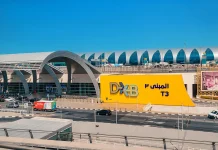report published yesterday by “Simple Flying” said that Dubai International Airport, a remarkable success story that has its equivalent that began seventy years ago, culminated in Dubai becoming a global aviation hub, and its airport became one of the most impressive and admired airports in the world.
One runway compacted with sand
He pointed out that in 1959, the late Sheikh Rashid bin Saeed Al Maktoum, may God rest his soul, the ruler of Dubai at the time, ordered the construction of an airport four kilometers west of Dubai, and after only one year, Dubai airport began operations, with an 1800-long runway. Meters of compressed sand, three circulation zones, a plaza, and a small passenger terminal.
“This simple airport was soon upgraded,” he said. In 1963, work began on a 2,800-meter-long asphalt runway. The passenger terminal was also expanded, hangars were built, Dubai invested in navigational aids and lighting for new airports, and the new runway was operational by 1965 and operated in conjunction with the existing sandy runway.
The development process and the beginnings of a development boom across the Emirates began to attract airlines. By the end of the decade, it became possible to travel from Dubai to 20 destinations, and from here was the beginning.
Jumbo and Concorde jets
The report stated that in the early 1970s, the runway was extended to 3,810 meters. This coincided with the emergence of Boeing 747 and Concorde aircraft on the scene, due to the need for both types to have wide runways.
Competition with neighboring airports helped spur the development of Dubai Airport. Indian Airlines, British Airways, Singapore Airlines, Cathay Pacific and Malaysia Airlines were among the airlines that made stops in Dubai.
The beginning of Emirates Airlines
In 1985, the report said, Emirates Airlines launched. It was a simple start that began with the operation of a Boeing 737 and A300 leased aircraft between Dubai and Pakistan. But Emirates Airlines will continue to put Dubai airport and Dubai on the global map.
In the mid-1980s, Dubai completed the second asphalt runway, which is a runway capable of accommodating the largest aircraft. It housed the latest meteorological systems, airport lighting and landing systems, enough to give Dubai Airport a Category II ICAO classification.
With Terminal 2 operating and Terminal 1 operating successfully in the past decade, Dubai Airport began planning Terminal 3. When it opened in 2008, this massive terminal increased the airport’s annual capacity by 47 million. It was a dedicated terminal for Emirates Airlines. In its first month of operations, Emirates Airlines carried 500,000 passengers through the terminal.
By the end of the first decade of the twenty-first century, Dubai Airport enjoyed an average annual growth in aircraft traffic of 12.4% and an average annual growth in passenger traffic of 15.5%. In the other half of the airport’s life, most of this growth has been driven by the growth of Emirates Airlines. In the 12 years between 1998 and 2010, passenger traffic through Dubai Airport increased from about 10 million annually to 40 million.
The report concluded by saying: The development boom in Dubai has witnessed a significant increase in demand for travel to and from the region. It is now possible to fly directly to Dubai from six continents.
The fastest growing and most profitable
Dubai Airport is one of the fastest growing and most profitable airports in the world. In 2019, the airport handled 88 million passengers, saw nearly 410,000 flight movements, and provided direct connections to 270 destinations. Dubai Airport has come a long way since its first runway made of compressed sand.




